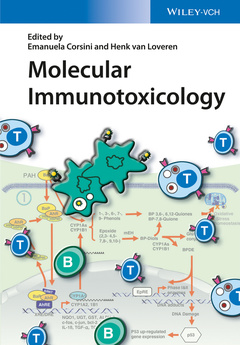Molecular Immunotoxicology
Coordonnateurs : Corsini Emanuela, Van Loveren Henk

Following an introduction to the various pathways and toxicity mechanisms from a systemic perspective, the main part of this comprehensive reference surveys individual molecular mechanisms of important immunotoxicants, from PAHs to biopharmaceuticals, and from receptor-mediated toxicity to nanoparticle toxicity, using analyses based on molecular effects rather than on animal models.
Taken together, the knowledge presented here provides an up-to-date overview of this hot topic that can be directly applied to the prediction and characterization of immunotoxic effects in drugs, chemicals, and environmental contaminants.
THE EVOLUTION OF IMMUNOTOXICOLOGY
Introduction
Immune-Mediated Environmental Lung Diseases
Immunotoxic Drug Reactions
Autoimmunity
Immunosuppression
Allergic Contact Dermatitis (ACD)
Summary
OVERVIEW OF THE MECHANISMS UNDERLYING CHEMICAL-INDUCED IMMUNOTOXICOLOGY
Introduction
Mechanisms of Immunotoxicity
Conclusions
USE OF TOXICOGENOMICS IN IMMUNOTOXICOLOGY
Introduction
Toxicogenomics
Bioinformatics and Data Analysis
Multiple Omic Approaches in the Evaluation of Immunosuppressive Compounds
Summary and Conclusions
BREAKDOWN OF THE MOLECULAR PROCESSES DRIVING THE ADVERSE OUTCOME PATHWAYS (AOPs) OF SKIN AND RESPIRATORY SENSITIZATION INDUCTION IN HUMANS EXPOSED TO XENOBIOTICS AND PROTEINS
Introduction
The AOP for Skin Sensitization
The Molecular Processes in the MOA for Sensitization Induction
Summary
CHEMICAL ALLERGEN-INDUCED SKIN CELL ACTIVATION
Introduction
Breaching in Barriers
Role of the Extracellular Matrix in Skin Inflammation
Cytoprotective Responses and Skin Inflammation
Skin Dendritic Cells -
Tolerance versus Immunity
DC Activation and Migration
The Role of Danger Signals
Inappropriate/Compromised DC Activation
T-Cell Activation and Immune Regulation
Allergic Contact Dermatitis as a (Sterile) "Infection" -
Implications
THE ARYL HYDROCARBON RECEPTOR (AhR) AS A MEDIATOR OF ADVERSE IMMUNE REACTIONS
Introduction
The Arylhydrocarbon Receptor - a Sensor of Chemicals and a Link to Our Chemical Environment
Immunotoxicity of TCDD, the Paradigm Ligand of AhR
AhR-Deficient Animal Models to Study AhR Function in the Immune System
Concluding Remarks
IMMUNOTOXICOLOGICAL EFFECTS OF PHARMACEUTICALS ON SIGNAL TRANSDUCTION IN INNATE AND ADAPTIVE IMMUNITY
Introduction
Drug Affecting Signal Transduction in Innate Immunity
Drug affecting Signal Transduction in Adaptive Immunity
PROMISES AND CHALLENGES WITH IMMUNOMODULATORY BIOLOGICS
Introduction
Adaptive Immunity in the Control of Tumors
Recent Developments in Oncology Immunotherapy -
Case Examples
Conclusions
THE NONCLINICAL EVALUATION OF BIOTECHNOLOGY-DERIVED PHARMACEUTICALS, MOVING ON AFTER THE TEGENERO CASE
The TeGenero (TGN1412) Case
The EU CHMP Risk Mitigation Document
MABEL versus NOAEL Approach
Predictivity of Antibody Properties, Pharmacodynamics, Pharmacokinetics, and Toxicology
New Developments in Biological Testing: In Vitro Approaches?
Cytokine Release Assays
Conclusions
GLUCOCORTICOLD-INDUCED IMMUNOMODULATION
Introduction
Mechanism of Action
GC Resistance
GC Effects on the Immune System
GC, Inflammation, and Immunosuppression
GC and Autoimmunity
Conclusions and Perspectives
PARTICULATE MATTER-INDUCED IMMUNE ACTIVATION
Background and Introduction
The Human Evidence
Do Physical or Chemical Particle Components Mediate Immune Stimulation?
Particle Adjuvant Effect -
The Primary and Secondary Response
Particle Properties and Adjuvant Effect -
Size is a Critical Factor
Interactions of Particles with the Immune System
Genetic Factors
Mechanisms of Particle Adjuvanicity
Oxidative Stress
Summary and Conclusions
GENOTOXIC MECHANISMS OF PAH-INDUCED IMMUNOTOXICITY
Introduction
General Chemical Structure of PAHs
Aryl Hydrocarbon Receptor (AhR)-Mediated Immunotoxicity Pathways
PAH-Induced Immunotoxicity via AhR-Independent Pathway
Microsomal Epoxide Hydrolase (mEH)
Genotoxic Pathways
PAH-Induced Apoptosis Pathways in T Cells, B Cells, and Macrophages
IMMUNOTOXIC EFFECTS OF PERFLUOROALKYLATED COMPOUNDS: MECHANISMS OF ACTION
Introduction
Immune Effects of PFOA and PFOS in Animal Models
Immune Effects of PFOA and PFOS in Humans
Mechanisms of Action
Conclusions
PESTICIDE-INDUCED IMMUNOTOXICITY: MOLECULAR TARGETS
Introduction
Summary
MODE OF ACTION OF ORGANOTINS IN IMMUNE CELLS
Introduction to Tributyltin Compounds
Findings on Immunotoxicity of TBTs Based on Animal Studies
Differential Effects of TBTs on Prenatal, Postnatal, or Adult Rats
Lactational Transfer of TBT
Effects of Organotin Compounds on the Immune Function of Aquatic Organisms
Modes of Action of TBTO as Assessed by Cytological and Biochemical Assays
Toxicogenomics Studies on the Modes of Action of TBTs
Summary
Index
Henk van Loveren got his PhD at Utrecht University (The Netherlands). He spent a post-doc period at Yale University, New Haven (USA), and subsequently joined the Netherlands National Institute of Public Health and the Environment at Bilthoven, where he directs the immunotoxicology program. He is also professor of immunotoxicology at Maastricht University. From 2000 to 2003 he was the chair of the Immunotoxicology and Chemical Specialty Section at EUROTOX. He serves as the director of the WHO/IPCS Collaborative Centre of Immunotoxicology and Allergic Hypersensitivity, has served at the Nutrition, Dietetic Products and Allergies Panel of EFSA, and is currently member of the CONTAM Panel of EFSA. For his activities in the field of Immunotoxicology he got the Vos Career Achievement Award of the SOT in 2008, and the Merit Award from EUROTOX in 2010.
Date de parution : 11-2014
Ouvrage de 352 p.
17.3x24.6 cm
Disponible chez l'éditeur (délai d'approvisionnement : 14 jours).
Prix indicatif 163,43 €
Ajouter au panierThèmes de Molecular Immunotoxicology :
Mots-clés :
contaminants; constantly; human; system; immune; food; chemicals; response; activate; components; indirectly; others; chemical; effect; different; action; many; mechanisms; systemic; pathways; perspective



